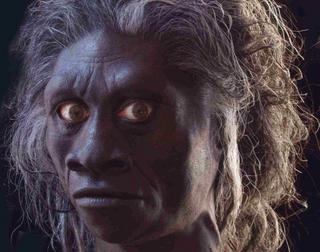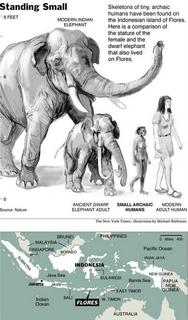


Nature Magazine will be reporting Wednesday on the latest information coming out of the excavations at Laing Bua cave, where a sensational tiny hominid skeleton was found last year. The article is supposed to be embargoed until tomorrow, but much of the information in it has leaked out. Controversy has raged ever since the first fossil was found as to whether the remains were evidence of a new hominid species, Homo Floriensis, or were a microcephalic homo erectus. Now, apparently, fossils from at least nine other individuals have been found, providing strong support for the position that they represent a separate species.
AFP reports:
A tiny hominid whose discovery in a cave on an Indonesian island unleashed one of the fiercest debates in anthropology has suddenly been joined by several other sets of dwarf-sized beings.
At least nine other wee individuals lived in the cave, where thousands of years ago they skilfully butchered meat and handled fire, according to new findings.
The initial find at Liang Bua cave, reported almost exactly a year ago, became known as the Hobbit Hominid, after the pint-sized characters of J.R.R. Tolkien's stories.
Measuring just a metre or so (3.25 feet) high -- thus as tall as a chimpanzee -- and with a skull the size of a grapefruit, the strange creature lived around 18,000 years ago on the remote island of Flores.
The discoverers believed the Hobbit to be the smallest of the 10 species of Homo erectus, the primate that emerged from Africa about 2.5 million years ago and whose ultimate descendant is Homo sapiens, as anatomically modern man is called.
They honoured him with the formal name of Homo floresiensis, "Man of Flores," and in so doing unleashed tribal warfare among anthropologists.
....The new fossils consist of the right elbow and two bones of the lower forearm of the first skeleton; the mandible of a second individual; and assorted other remains, including two tibiae, a femur, two radii, an ulna, a scapula, a vertebra and various toe and finger bones.
In all, bits and pieces from at least nine individuals have been found, and dating of the remains suggest some were alive as recently as 12,000 years ago.
All seem to have been the same size as the original Hobbit. In addition, the new bones show that these people, for all their short size, had relatively long arms and, unlike H. sapiens, had no chin.
The finds thus prove that the first Hobbit "is not just an aberrant or pathological individual, but is representative of a long-term population that was present during the interval (of) 95-74,000 to 12,000 years ago," the Australian-Indonesian team say.
But that's not all. Gently extracted from Liang Bua's floor were the remains of a dwarf elephant called a Stegodon, whose bones, marked by flints, showed that the hobbits were good at butchering animals.
There were also scarred bones and clusters of reddened, flame-cracked rocks, proof that the community was skillful at manipulating fire.
Read it here.
The New Scientist has an article here.
WaPo writes it up here.
The Discovery Channel adds some interesting quotes:
Roberts, a professor and senior research fellow in the School of Earth & Environmental Sciences at the University of Wollongong, Australia, explained to Discovery News that the hobbits lacked chins and possessed very long arms that reached almost to their knees.
When full-grown they stood only about three feet three inches tall and had brains equivalent in size to those of today's chimpanzees.
Peter Brown, another author of the study who is professor of archaeology and palaeoanthropology at Australia's University of New England, told Discovery News that the hobbits were hunter-gatherers.
"Evidence suggests that they lived in the cave, made stone tools, hunted Stegodon (an animal that looked like a tiny elephant) and ate rainforest vegetation," Brown said.
The tool evidence unearthed by Brown and his colleagues includes stone flaking debris, stone cores, retouched tools and anvils. The scientists also found butchered Stegodon bones and bones for Komodo dragons, rats and bats in the cave.
"The Komodo dragons could have lived and scavenged in the cave," Brown explained. "Rats also could have lived in the cave. Stegodon were food!"
Causing a Stir
At first, Brown thought H. floresiensis evolved from Homo erectus, but now he believes the hobbits were more closely linked to Australopithecus, a more apish-looking human ancestor that walked upright but had long arms.The researchers think the hobbits represent a new species of human that could have inhabited other Indonesian islands.
Daniel Lieberman, professor of biological anthropology at Harvard University, told Discovery News that he was unavailable for comment, but he wrote a News & Views piece in Nature on the recent finds.
"Homo floresiensis caused a stir by challenging preconceptions," Lieberman wrote. "If it is a new species, then we shared this planet with other hominids much more recently than anyone thought — long after the Neanderthals became extinct, after modern humans arrived in Australia, and at about the same time that agriculture was first invented."
Lieberman, who theorizes that resource restraints and small island population sizes could have dwarfed the hobbits, hopes future testing of the skeletal remains may determine if they are smaller versions of H. erectus, modern humans, or even some other as-of-yet unknown human ancestor.
Read it here.
"Australopithecus," really! Interesting!
UPDATE:
The NYT has a short piece on the new evidence here.
National Geographic, which has been pushing the new species interpretation strongly right from the beginning has a long and informative piece here.
Karl Zimmer has an excellent overview of the whole controversy over at the Loom [here].
And, for the Australopithecine perspective see John Hawks' post here. Unlike the other authors, Hawks is actually a real scientist working in the field. His posts are probably your best source of good information, even if he is pushing a specific interpretation of the evidence.
No comments:
Post a Comment